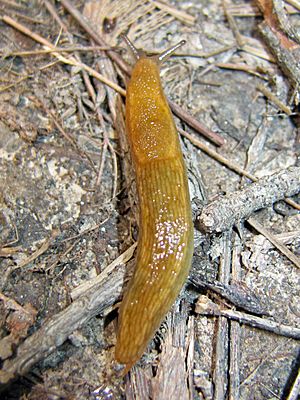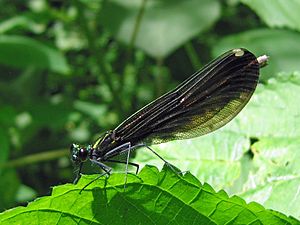Invertebrates of the Indiana Dunes facts for kids
Indiana Dunes National Park is a special place on the shore of Lake Michigan in Indiana, United States. It's a national park managed by the National Park Service. In 2009, something cool called a BioBlitz happened there. A BioBlitz is like a big scavenger hunt where scientists and volunteers try to find and list as many living things as possible in a short time. During the BioBlitz on May 15 and 16, 2009, they made a list of many different organisms, including tiny creatures called invertebrates.
Contents
What are Invertebrates?
Invertebrates are animals that do not have a backbone. This includes a huge variety of creatures like insects, spiders, worms, snails, and many more! They are super important for the environment. They help with things like breaking down dead plants and animals, pollinating flowers, and being food for other animals.
Mollusks: Snails, Slugs, and More!
Mollusks are a group of invertebrates that often have soft bodies. Many mollusks, like snails and clams, have a hard shell to protect themselves. Others, like slugs, do not have an outer shell.
At Indiana Dunes, you can find many types of mollusks, including different kinds of snails, slugs, and mussels. These creatures play a role in the park's ecosystem. For example, some snails eat algae, helping to keep the water clean.
Millipedes: Many Legs!
Millipedes are another type of invertebrate found at the park. They are known for having many, many legs! The word "millipede" actually means "thousand feet," even though they don't really have that many. They usually have two pairs of legs on most of their body segments.
Millipedes are often found in damp, dark places, like under logs or leaves. They are decomposers, meaning they help break down dead plants. This is very important for keeping the soil healthy.
- Narceus americanus - This is a common type of millipede found in North America, sometimes called the North American millipede.
- Diplopoda sp. - This refers to other types of millipedes that belong to the group called Diplopoda.
Other Invertebrates: Roundworms
Besides mollusks and millipedes, other invertebrates also live in Indiana Dunes National Park. One example is a type of roundworm.
Roundworms are simple, tube-shaped worms that can be found in many different environments, including soil and water. They are a very diverse group of animals.



